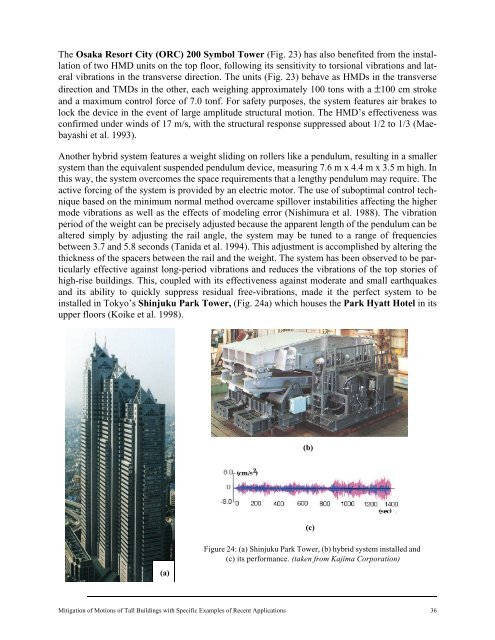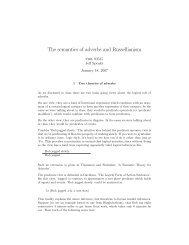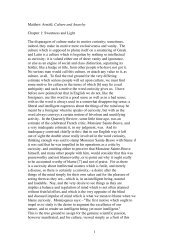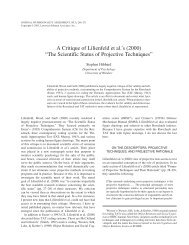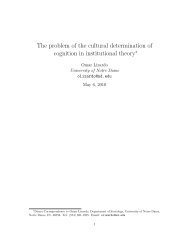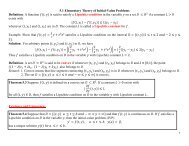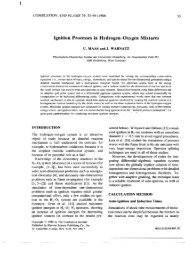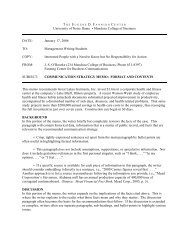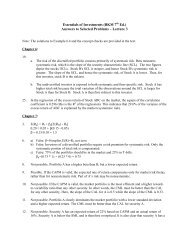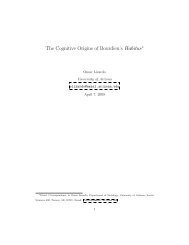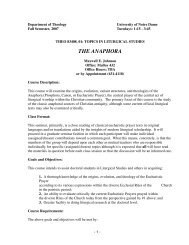Mitigation of Motions of Tall Buildings with Specific Examples of ...
Mitigation of Motions of Tall Buildings with Specific Examples of ...
Mitigation of Motions of Tall Buildings with Specific Examples of ...
Create successful ePaper yourself
Turn your PDF publications into a flip-book with our unique Google optimized e-Paper software.
The Osaka Resort City (ORC) 200 Symbol Tower (Fig. 23) has also benefited from the installation<br />
<strong>of</strong> two HMD units on the top floor, following its sensitivity to torsional vibrations and lateral<br />
vibrations in the transverse direction. The units (Fig. 23) behave as HMDs in the transverse<br />
direction and TMDs in the other, each weighing approximately 100 tons <strong>with</strong> a ±100 cm stroke<br />
and a maximum control force <strong>of</strong> 7.0 tonf. For safety purposes, the system features air brakes to<br />
lock the device in the event <strong>of</strong> large amplitude structural motion. The HMD’s effectiveness was<br />
confirmed under winds <strong>of</strong> 17 m/s, <strong>with</strong> the structural response suppressed about 1/2 to 1/3 (Maebayashi<br />
et al. 1993).<br />
Another hybrid system features a weight sliding on rollers like a pendulum, resulting in a smaller<br />
system than the equivalent suspended pendulum device, measuring 7.6 m x 4.4 m x 3.5 m high. In<br />
this way, the system overcomes the space requirements that a lengthy pendulum may require. The<br />
active forcing <strong>of</strong> the system is provided by an electric motor. The use <strong>of</strong> suboptimal control technique<br />
based on the minimum normal method overcame spillover instabilities affecting the higher<br />
mode vibrations as well as the effects <strong>of</strong> modeling error (Nishimura et al. 1988). The vibration<br />
period <strong>of</strong> the weight can be precisely adjusted because the apparent length <strong>of</strong> the pendulum can be<br />
altered simply by adjusting the rail angle, the system may be tuned to a range <strong>of</strong> frequencies<br />
between 3.7 and 5.8 seconds (Tanida et al. 1994). This adjustment is accomplished by altering the<br />
thickness <strong>of</strong> the spacers between the rail and the weight. The system has been observed to be particularly<br />
effective against long-period vibrations and reduces the vibrations <strong>of</strong> the top stories <strong>of</strong><br />
high-rise buildings. This, coupled <strong>with</strong> its effectiveness against moderate and small earthquakes<br />
and its ability to quickly suppress residual free-vibrations, made it the perfect system to be<br />
installed in Tokyo’s Shinjuku Park Tower, (Fig. 24a) which houses the Park Hyatt Hotel in its<br />
upper floors (Koike et al. 1998).<br />
(a)<br />
Figure 24: (a) Shinjuku Park Tower, (b) hybrid system installed and<br />
(c) its performance. (taken from Kajima Corporation)<br />
<strong>Mitigation</strong> <strong>of</strong> <strong>Motions</strong> <strong>of</strong> <strong>Tall</strong> <strong>Buildings</strong> <strong>with</strong> <strong>Specific</strong> <strong>Examples</strong> <strong>of</strong> Recent Applications 36<br />
(b)<br />
(c)


